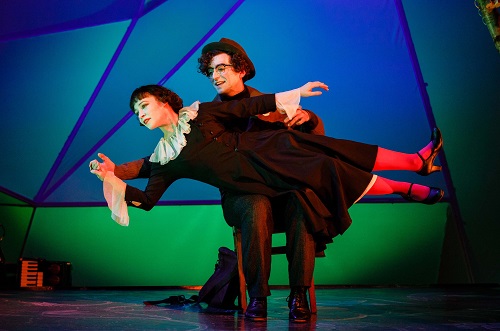 United States Daniel Jamieson and Ian Ross, The Flying Lovers of Vitebsk: Artists and Musicians of Kneehigh / Ian Ross (music director), Wallis Annenberg Center for the Performing Arts, Beverly Hills, 24.2.2018. (JRo)
United States Daniel Jamieson and Ian Ross, The Flying Lovers of Vitebsk: Artists and Musicians of Kneehigh / Ian Ross (music director), Wallis Annenberg Center for the Performing Arts, Beverly Hills, 24.2.2018. (JRo)

Cast:
Marc Chagall – Marc Antolin
Bella Chagall – Daisy Maywood
Musician – James Gow
Musician – Ian Ross
Production:
Writer – Daniel Jamieson
Director – Emma Rice
Composer – Ian Ross
Choreographers – Emma Rice and Etta Murfitt
Set and Costume Design – Sophia Clist
Lighting Design – Malcolm Rippeth
This intimate musical play glows with possibility – the possibility to contextualize Marc Chagall’s place in the history of art through words, song and movement, and the possibility to transform his passion for his wife, Bella, into an understanding of the iconic imagery found in his work. At its best, the play brims with inventive stagecraft, evocative and idiosyncratic choreography and the talents of an exuberant pair of actors in the roles of Marc and Bella Chagall.
Where it fails, however, is in its structure. Covering too much time in the artist’s life, it defies Aristotle’s three unities – action, time and place – and takes the audience hopping from Vitebsk to Paris and Berlin, back to Vitebsk, then to St. Petersburg, back to Vitebsk and finally to New York. The action begins in 1909 when Chagall meets his future wife, Bella Rosenfeld, and covers their relationship until her death from a viral infection in 1944. Reading more like a timeline of the couple’s life than a concise drama, the multi-talented actors, Marc Antolin and Daisy Maywood, are swallowed up in a narrative stream, which thankfully stops at interludes to allow the music, dance and singing to prevail.
Ian Ross created a score reminiscent of synagogue, klezmer and Russian music, sung beautifully by Antolin and Maywood and often accompanied vocally by Ross and James Gow, performing on keyboard, cello and an array of instruments. The jazz standard, ‘I’m Making Believe’, was featured prominently as an ode to the couple’s love. It is in these moments, and through the stylized choreography of Etta Murfitt and Emma Rice, that Chagall’s life and inspiration was allowed room to soar. Arching backs, imitations of flight and snippets of Russian folk dance evoked Chagall’s familiar imagery and connected the audience more to his life and work than the heavy handed exposition.
The effective set by Sophia Clist, composed of a steeply raked platform surrounded by poles and posts, suggested a succah (a temporary hut constructed to celebrate the Jewish harvest festival of Succoth) and made reference to the Yiddish culture that inspired Chagall’s work. Attached ropes allowed the actors to lean and sway against a backdrop of faceted planes colorfully illuminated with Chagall’s palette of vivid reds, purples, yellows, blues and greens. Malcolm Rippeth’s lighting went a long way to create a painterly atmosphere and yet, what I wanted, more than atmosphere and song, was some special insight into Chagall’s relationship to his art and his homeland.
Chagall was a painter of a nostalgic past that was being rapidly eradicated by the Russian Revolution and the rising of the abstract art of Suprematism and Constructivism. Lauded in Berlin and Paris, but ultimately rejected in Russia by his revolutionary colleagues, Chagall persisted on his independent course – a bold decision for any creative person. But here, in The Flying Lovers of Vitebsk, we have a Chagall who mopes and complains about his lot and seems impervious to the ideals of the politics of his day. And yes, this is primarily a love story, but the author has chosen to set his tale against the backdrop of a tumultuous piece of Russian history that was dismissed by Chagall in the play when, like an errant schoolboy, he drew horns and fangs on a sculpture of Karl Marx.
The play was at its most poignant dramatically when dealing with Bella’s tribulations as a woman lost in the shadow of her husband’s gifts. An intellectual who studied philosophy and literature, her longing to be more than a mother and helpmate spoke to women’s needs and brought the past into the present with an immediacy lacking in the rest of the script.
In the moments of stylized movement set to Ross’s music and so poetically enacted by the principals, I longed for the Chagalls’ love story to be turned into pure dance. As so exquisitely displayed at the recent Los Angeles County Museum of Art show, ‘Chagall: Fantasies for the Stage’, the artist was a Balanchine of the canvas and a Mozart of the brush. Who better than the painter himself to become the subject of a ballet? Go to the Wallis, if only to bask in the glow of possibility.
Jane Rosenberg